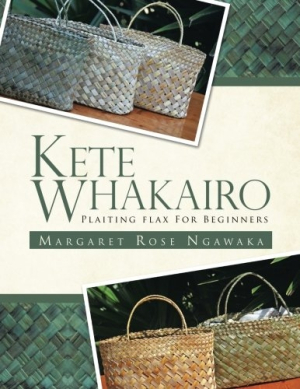Kete Whakairo
Plaiting Flax for Beginners
Organized beautifully and written with friendly instruction and care, this guide is a valuable addition to the craft genre.
For lovers of general handcrafts who are seeking new challenges or for experienced fiber artists, Margaret Rose Ngawaka’s book, Kete Whakairo, will be a useful and concise resource. With clear photos of every step in the process and an encouraging and enlightening narrative, Ngawaka introduces her community and its culture while providing an easy-to-follow tutorial. This is not a collection of kete whakairo patterns or a researched history of the art form; it is a look at one traditional product and a technique which is easy to understand and doesn’t overwhelm.
A kete whakairo is a type of basket made by the indigenous people of New Zealand; it is created from diagonally interlocking multiple blades of a particular flax plant in a method called raranga. Ngawaka humbly admits throughout the book that she is not the foremost expert on the art of raranga, but that its connection with her family heritage and the importance of preserving this art prompted her to share her experience. Her brief introduction to the uses and significance of the kete whakairo, its decline when commercially available resources became available, and the perseverance of this traditional basket as both a functional and cultural artifact are concise and informative.
Much attention is paid to the cutting and preparing of the raw material, a plant called harakeke—but those without a harakeke growing in their backyard are told of no other resource. If there are materials available regionally or by order, it would have been considerate to include that information in the appendix. As it is, Ngawaka often refers to classes, tutors, and tools throughout the text but offers no contacts or tips for seeking out these resources. It may put beginners at a disadvantage and perhaps lessen their interest in trying raranga for themselves.
Ngawaka’s book is organized beautifully, and more than one hundred full-color photographs walk through every bend and fold of fiber, seamlessly introducing unique vocabulary and eliminating any confusion with other forms of weaving. Though the technique likely takes a bit of time to master, this book makes it easy to create one’s first kete whakairo, and there is joy in Ngawaka’s method of guidance. An occasional note to watch out for a common pitfall or to reassure weavers that a difficult step in the process will take practice adds a welcome sincerity. In the best way, it seems as though this is a book written by a good friend.
Ngawaka’s Kete Whakairo is a valued addition to the vast genre of craft and art instruction guides. It does not try to be a compendium of patterns and possibilities or overwhelm the novice. Instead, it allows the functional and beautiful raranga to inspire weavers at any skill level. Ngawaka plans to follow up Kete Whakairo with a second book to address colors and patterns. It will be worth watching for.
Reviewed by
Sara Budzik
Disclosure: This article is not an endorsement, but a review. The publisher of this book provided free copies of the book and paid a small fee to have their book reviewed by a professional reviewer. Foreword Reviews and Clarion Reviews make no guarantee that the publisher will receive a positive review. Foreword Magazine, Inc. is disclosing this in accordance with the Federal Trade Commission’s 16 CFR, Part 255.

